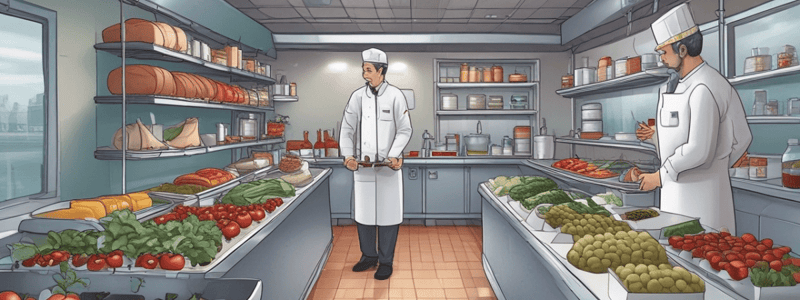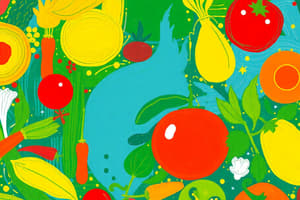Podcast
Questions and Answers
What is the temperature range in which food is usually at risk of bacterial growth?
What is the temperature range in which food is usually at risk of bacterial growth?
- 100°C to 200°C
- 0°C to 4°C
- 60°C to 100°C
- 5°C to 57°C (correct)
It's recommended to handle foods as much as possible to ensure cleanliness.
It's recommended to handle foods as much as possible to ensure cleanliness.
False (B)
What should you do when working with raw poultry, meat, fish, or eggs?
What should you do when working with raw poultry, meat, fish, or eggs?
Clean and sanitize cutting surfaces and equipment after handling raw poultry, meat, fish, or eggs and before working on another food.
When bringing foods out of refrigeration, do not bring out more than you can process in ______ hour.
When bringing foods out of refrigeration, do not bring out more than you can process in ______ hour.
What is the purpose of the 'four-hour rule'?
What is the purpose of the 'four-hour rule'?
Match the following food safety guidelines with their descriptions:
Match the following food safety guidelines with their descriptions:
It's recommended to wash raw fruits and vegetables thoroughly before consuming.
It's recommended to wash raw fruits and vegetables thoroughly before consuming.
What should you do when tasting food?
What should you do when tasting food?
What is the recommended temperature for reheating previously cooked food in Scotland?
What is the recommended temperature for reheating previously cooked food in Scotland?
Food spoilage is always caused by bacterial contamination.
Food spoilage is always caused by bacterial contamination.
What is the time frame to cool food to 8°C when chilling?
What is the time frame to cool food to 8°C when chilling?
When freezing food, it must be frozen to a temperature of ______________ within 4 hours.
When freezing food, it must be frozen to a temperature of ______________ within 4 hours.
Why is it essential to handle food at the correct temperature during holding for service?
Why is it essential to handle food at the correct temperature during holding for service?
It is recommended to reheat cooked food multiple times before serving.
It is recommended to reheat cooked food multiple times before serving.
Signs of food spoilage include __________________ and __________________.
Signs of food spoilage include __________________ and __________________.
Match the following food safety guidelines with their purposes:
Match the following food safety guidelines with their purposes:
What is the maximum time allowed to cool food from 135°F (57°C) to 70°F (21°C) in the two-stage cooling method?
What is the maximum time allowed to cool food from 135°F (57°C) to 70°F (21°C) in the two-stage cooling method?
The temperature range between 5°C and 125°C is the most dangerous part of the Food Danger Zone.
The temperature range between 5°C and 125°C is the most dangerous part of the Food Danger Zone.
What is the minimum temperature that most food should be cooked to in order to kill bacteria?
What is the minimum temperature that most food should be cooked to in order to kill bacteria?
The temperature range between __________ and 63°C is referred to as the danger zone.
The temperature range between __________ and 63°C is referred to as the danger zone.
Match the following temperature ranges with their descriptions:
Match the following temperature ranges with their descriptions:
What should be done if food has not cooled to 70°F (21°C) within 2 hours in the two-stage cooling method?
What should be done if food has not cooled to 70°F (21°C) within 2 hours in the two-stage cooling method?
Electronic temperature probes are only used to measure the temperature of hot food.
Electronic temperature probes are only used to measure the temperature of hot food.
Why is it important to cool food quickly?
Why is it important to cool food quickly?
What is the recommended temperature for refrigerators and chill cabinets?
What is the recommended temperature for refrigerators and chill cabinets?
Freezers should be below -18°C.
Freezers should be below -18°C.
What is the recommended core temperature for cooked food?
What is the recommended core temperature for cooked food?
Food should be cooked to a core temperature of __________ for two minutes.
Food should be cooked to a core temperature of __________ for two minutes.
Match the following food temperatures with their descriptions:
Match the following food temperatures with their descriptions:
It is recommended to defrost frozen food at room temperature.
It is recommended to defrost frozen food at room temperature.
How long should thawed food remain at refrigerator temperatures before being cooked?
How long should thawed food remain at refrigerator temperatures before being cooked?
When defrosting frozen food, it is recommended to place it in a deep tray, cover with __________, and label it.
When defrosting frozen food, it is recommended to place it in a deep tray, cover with __________, and label it.
What should you do with leftover gravies, sauces, soups, and vegetables before serving?
What should you do with leftover gravies, sauces, soups, and vegetables before serving?
It's recommended to mix leftovers with freshly prepared foods.
It's recommended to mix leftovers with freshly prepared foods.
Why is it important to chill custards, cream fillings, and other hazardous foods quickly?
Why is it important to chill custards, cream fillings, and other hazardous foods quickly?
Minimum internal cooking temperatures are essential to kill __________________ at a specified period.
Minimum internal cooking temperatures are essential to kill __________________ at a specified period.
Why do large batches of food cool more slowly?
Why do large batches of food cool more slowly?
It's recommended to use unsanitary thermometers to measure internal temperatures.
It's recommended to use unsanitary thermometers to measure internal temperatures.
Match the following cooling methods with their descriptions:
Match the following cooling methods with their descriptions:
What is the purpose of cooling cooked foods quickly?
What is the purpose of cooling cooked foods quickly?
Study Notes
Sanitation Problems in Food Handling and Preparation
- Two major sanitation problems: cross contamination and food in the Food Danger Zone (5°C to 57°C or 41°F to 135°F)
- Lag phase of bacteria growth helps, but foods must be kept out of the danger zone whenever possible
Preventing Sanitation Problems
- Start with clean, wholesome foods from reputable purveyors
- Handle foods as little as possible using utensils instead of hands
- Use clean, sanitized equipment and worktables
- Clean and sanitize cutting surfaces and equipment after handling raw foods and before working on another food
- Place only food items and sanitary knives or tools on cutting boards
- Clean as you go and keep clean cloths and sanitizing solution handy
- Wash raw fruits and vegetables thoroughly
- Limit the time foods spend in the Food Danger Zone
- Keep foods covered unless in immediate use
- Observe the four-hour rule
- Cook foods to minimum internal cooking temperatures
- Taste foods properly using a clean spoon and discard utensils after use
- Boil leftover gravies, sauces, soups, and vegetables before serving
- Don't mix leftovers with freshly prepared foods
- Chill all ingredients for protein salads and potato salads before combining
- Cool and chill foods quickly and correctly
Minimum Internal Cooking Temperatures
- Minimum internal cooking temperature is the internal temperature at which microorganisms are killed
- Must be held at that temperature for a specified period for the food to be considered safe
- Measure internal temperatures in at least two or three places using a sanitary thermometer
Cooling Procedures
- Cool foods quickly to avoid spending too much time in the Food Danger Zone
- Use either the two-stage cooling method or the one-stage cooling method
- Two-stage cooling method: cool from 135°F (57°C) to 70°F (21°C) in no more than 2 hours, and then from 70°F (21°C) to below 41°F (5°C) within an additional 4 hours
- One-stage cooling method: cool to below 41°F (5°C) in no more than 4 hours
- If food does not reach the desired temperature, reheat to 165°F (74°C) and hold at that temperature for at least 15 seconds and then cool again
Temperature Control
- Temperatures between 5°C and 63°C are the danger zone for bacterial growth
- Cook food through the danger zone quickly
- Most food should be cooked to 75°C to kill bacteria
- Cool food quickly (within 90 minutes) to avoid the danger zone
- Use electronic temperature probes to measure temperatures
- Check and record refrigerator, freezer, and chill cabinet temperatures at least once a day
Preparation
- Monitor the time that food spends at kitchen temperatures and keep it to a minimum
- Prepare large amounts in batches, keeping the majority of the food refrigerated until needed
- Core temperature of food should not go above 8°C
- Defrost frozen food in a specific thawing cabinet or in a deep tray, covered with film and labeled
Cooking
- Cooking food to a core temperature of 75°C for two minutes will kill most bacteria
- Higher temperatures may be required for certain dishes or customer requirements
- Always cook to the higher recommended temperature when meat has been boned/rolled or minced, or where the food is part of a made-up dish
Chilling
- Cool food to 8°C within 90 minutes to prevent bacterial multiplication and spore growth
- Use a blast chiller to cool food quickly
Freezing
- Freeze food to --18°C within 4 hours to prevent bacterial growth and spore growth
- Use a proper blast freezer to freeze food quickly
Reheating
- Reheat previously cooked food to at least 75°C (82°C in Scotland)
- Maintain the temperature for at least two minutes and reheating must only be done once
Holding for Service, Serving, and Transporting
- Cooked food being held for service, served, or transported must be kept above 63°C for hot food or below 5°C for cold food
Food Spoilage
- Food spoilage is caused by the natural breakdown of the food by spoilage organisms
- Signs of spoilage include mould, slimy or over-wet/over-dry food, sour smell or taste, discoloured and wrinkled food, or texture changes
- Poor storage, handling, or contamination can also cause food spoilage
Studying That Suits You
Use AI to generate personalized quizzes and flashcards to suit your learning preferences.
Related Documents
Description
Learn about the importance of food safety during handling and preparation, including avoiding cross contamination and keeping food out of the danger zone.




